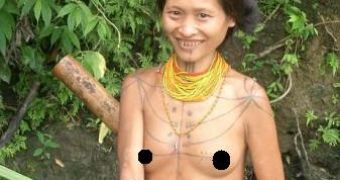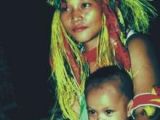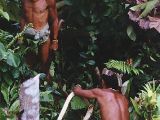West of Sumatra, away from the main trade routes, Mentawai Islands seem ideal for maintaining a life style known in other places 10,000 years ago. The largest island of the group is Siberut, located at 10 hours of boat traveling from Sumatra. Siberut is 110 km (68 mi) long and 50 km (30 mi) wide.
Until the beginning of the 20th century, few people visited these islands. Today, the coastal tribes, which make trade with Sumatra, started to use iron. But in the inner jungle, the only access method is using the pirogue, ascending on small swift rivers. At the end of such a journey, you can find a Neolithic world.
In the jungle of Siberut live the "Flower People", a population of 1,000 individuals, divided in various clans, who live outside civilization and communicate only with their kin from other tribes, and this only in emergency situations. These people live in huts raised on poles and covered by palm leaves. The huts do not belong to a family, but to a clan made of 3 to 10 families. Under the huts, a lot of small, black pigs wander. They are omnipresent in the archipelago and are destined, before all, for sacrificial ceremonies and food.
The Siberut jungle is a Biosphere Reserve, and this protects the "Flower People" from the invasion of the modern world and its most ardent and tireless messengers, the tourists. These people have resisted for a long time, facing Dutch and Indonesian intrusion.
The indigenous people of Mentawai are Proto-Malayan, like the Toraja of Celebes, Dayak of Borneo or Bataks of Sumatra, and arrived in the islands 5,000 years ago, during the Proto-Malayan migration. But the Mentawai people remained the most conservative, with their patriarchal society, because of their isolation.
The Flower People got their name because they use to wear flowers (especially Hibiscus) and leaves as adornments. Their clothes can be reduced to this and to a piece of bark around their waist. Other adornments are the tattoos and cut teeth.
Their adornments are meant to mesmerize their souls, which otherwise would detach from their bodies, leaving them defenseless against the diseases and death. That's why these people adorn themselves carefully each day, to attract, seduce and make their soul stay. Tattoos are meant to chase away the evil spirits and to attract the good ones. Their motifs represent birds in flight, bows and arrows.
Teeth cutting is an even more painful way of appeasing and taming the spirits. It is made without any anesthesia, with a wooden, two-headed hammer and a chisel. The pain is immense, and a wooden piece is inserted between the jaws of the patient during this 'surgery', so that the patient's mouth is kept open. After the operation, to stand the pain, the patient chews a plant with anaesthestetic properties.
For these people, every little part in their environment has its spirit. The "Flower People" never take the life of an animal or plant before asking for forgiveness from its spirit, explaining the reason why they do it. Cutting a tree is preceded by prays and small offerings. Nothing can function without the accord of the inhabiting spirit of the object. The cord of a bow must be addressed praying so that the bow should work.
Making a pirogue from a tree trunk starts with a great ceremony, which last 3-4 days, a time when the spirit of the pirogue is asked to allow the people to stay inside, not to overturn them, and protect them from dangers.
When a person is ill, a general joy starts, so that the sad spirit, wandering around, feel the pleasure to return in the body, recovering its vigor.
The most precious tree is the sago palm, and each family detains a plantation of these palms. The sago, a type of flour gotten by grinding the medulla of the palm, is the base food item in the diet of these people. The Mentawai people also cultivate taro on the wet banks of the rivers.
The main occupation of the men is hunting, while women and children gather plants and animals (like river crustaceans). Men hunt monkeys, deer and wild boars. At the end of each ritual a hunt takes place, attended exclusively by the shamans of the clans.
The Siberut tribes use a special tam-tam made of 3-4 hollowed trunks, tied to each other. The tam-tam transmits messages to a distance. These people use a sophisticated and impressive code, with different sonorities depending on the importance of the sent information. This drum is called tudukat, and in case of a latent conflict, a clan arriving from the hunt will spare no energy in announcing the hunt of an enormous deer or a fabulous monkey, anything that could make the adversaries furious and envious of it. The same code can be used by the adversaries to reply with a more swollen lie. The tension could rise and a bamboo arrow might be seen, thrown towards the enemies.
Great ceremonies are conducted by the shaman (sikerei) and a rimata, the master of ceremony of all the souls of the clan. First, white cocks and black pigs are sacrificed, so that the spirits of the shaman enter in harmony with each other. Each spirit produces a warm emanation called badju, which must be cooled down and appeased, so that, by forming a similar emanation, it would create a harmful effect. The rhythmic beat of the tudukat, music, dance, trance fall and embers walking follow subsequently.
Men never walk on embers outside the ceremonies. When, at the insistence of outsiders, they made incomplete, improvised or fake ceremonies, they always got their feet burned. Only the trance state induced by the ritual develops an inner power that maintains the immunity of the organism in front of negative external stimuli.
The ceremonies are caused by major events in the life of the clan: a memorable hunt, the reconciliation between two families, the curing of a child and so on.
The shamans, even if they use curative plants, they do not have real pharmaceutical knowledge. They do not know, but infer the curative properties of the plants. They walk through the forest, waiting for the message of the plant spirits.
Still, the world of Siberut is changing. Intruders pay a lot of money for taking pictures of the houses of the indigenous people and the Flower People have started to know the meaning of the money and to pretend them. The local resin gaaru (like frankincense) is appreciated by the Arabs, who snuff it. The gathering of gaaru starts to have an increasing importance.

 14 DAY TRIAL //
14 DAY TRIAL // 

